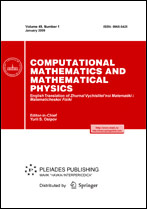|
Mathematical physics
Mathematical modeling of embolization of arteriovenous malformations with overflows on the basis of the two-phase filtering
T. S. Gologusha, V. V. Ostapenkoab, A. A. Cherevkoab
a Lavrent’ev Institute of Hydrodynamics, Siberian Branch, Russian Academy of Sciences, 630090, Novosibirsk, Russia
b Novosibirsk State University, 630090, Novosibirsk, Russia
Abstract:
Arteriovenous malformation (AVM) is a congenital pathology of the development of brain vessels in which the arterial and venous blood beds are directly connected by tangled degenerate vessels. This dangerous disease affects the brain functioning and increasing the risk of intracranial hemorrhage. A method of treating the AVM is embolization, which is the surgery of endovascular filling of AVM vessels by a special embolic agent to block blood flow through them. This method is widely used; however, it sometimes is accompanied by intraoperative rupture of AVM vessels. A combined model of the embolization process is proposed that, in addition to the flow of blood and embolic agent in the AVM, takes into account the overflow of blood into surrounding healthy vessels. For modeling the joint flow of blood and embolic composition within the AVM, a one-dimensional model of two-phase filtering is used. This model is built on the basis of clinical data of real patients obtained during neurosurgeries in the Meshalkin National Medical Research Center. Mathematically, this leads to a special initial boundary value problem for an integro-differential equation with a nonconvex flow. For numerical computations, a monotone modification of the CABARET scheme is constructed that highly accurately localizes the strong and weak discontinuities in the solution to the problem. The main purpose of this paper is to find the optimal scenario of the AVM embolization with respect to safety and efficiency. The objective functional and the constraints occurring in the resulting optimal control problem are chosen according to medical grounds. In the future, it is planned to use the optimal solutions obtained in this paper to improve the surgery technique and increase the safety of neurosurgical operations.
Key words:
two-phase filtering, CABARET scheme, optimal control, arteriovenous malformation, embolization.
Received: 01.02.2020
Revised: 19.01.2021
Accepted: 09.04.2021
Citation:
T. S. Gologush, V. V. Ostapenko, A. A. Cherevko, “Mathematical modeling of embolization of arteriovenous malformations with overflows on the basis of the two-phase filtering”, Zh. Vychisl. Mat. Mat. Fiz., 61:9 (2021), 1571–1584; Comput. Math. Math. Phys., 61:9 (2021), 1546–1558
Linking options:
https://www.mathnet.ru/eng/zvmmf11296 https://www.mathnet.ru/eng/zvmmf/v61/i9/p1571
|


| Statistics & downloads: |
| Abstract page: | 93 |
|





 Contact us:
Contact us: Terms of Use
Terms of Use
 Registration to the website
Registration to the website Logotypes
Logotypes







 Citation in format
Citation in format 